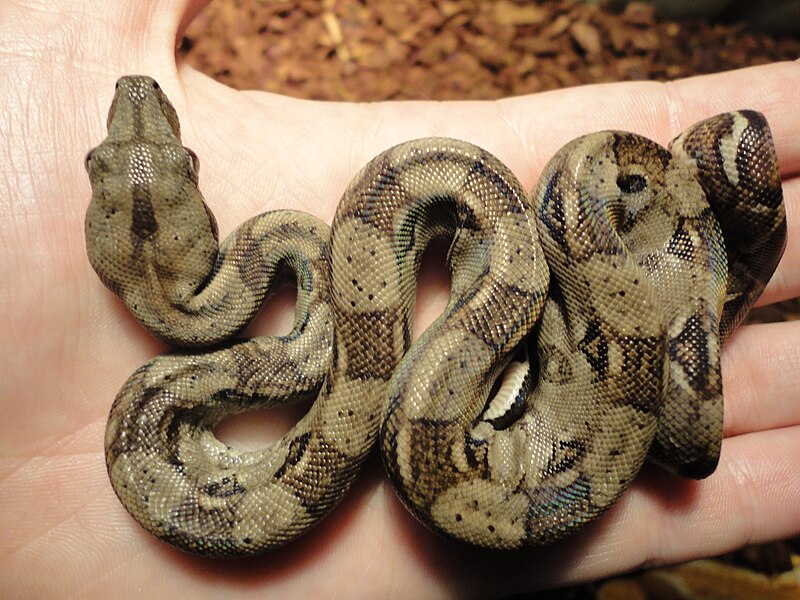 A female Boa (Boa constrictor) shocked herpetologists by giving birth to live young that she produced by cloning rather than mating. What’s more, the process used to create the young is new to the animal world – it has not been seen in any other vertebrate.
A female Boa (Boa constrictor) shocked herpetologists by giving birth to live young that she produced by cloning rather than mating. What’s more, the process used to create the young is new to the animal world – it has not been seen in any other vertebrate.
Asexual Births in other Species
Asexual reproduction or parthenogenesis – producing young without mating – is well known among insects and certain fishes (including Hammerhead Sharks), some of which can even switch sexes several times. It has also been recorded in a small number of reptiles, such as the Brahminy Blind Snake, American Whiptail Lizards and the Komodo Dragon.
Among certain Whiptail Lizards, the entire species seems to consist of females only, while in Komodo Dragons (and now Boas), females usually mate but have the “option” not to. Biologists debate the reasons for such an unusual strategy, but in the case of the Blind Snake, it has paid off – single females transported worldwide in soil (their alternate name is Flowerpot Snake) have established many populations far outside of their natural range, including several in Florida. Had they relied upon sexual reproduction, a pair or a fertilized female would be needed to start a new population – an unlikely event where stowaways are concerned.
A Completely New Type of Parthenogenesis
The discovery of a parthenogenic Boa was published this week (November, 2010) in the journal Royal Society Biology Letters. Researchers note that the female snake in question had previously mated and produced young, but then went on to produce 2 litters via cloning. They suspected something was amiss because all 22 youngsters were female, and caramel-colored, a recessive trait not carried by any of the potential fathers.

Observe and Share
The Boa Constrictor is one of the most thoroughly-studied snakes in the world, and millions have been bred in captivity. Yet we have only just now learned that it can reproduce by a means previously unknown to biologists.
Further Reading
Virgin Snake Mom: further details and photos of the uniquely-colored youngsters.
Asexual reproduction in sharks and Komodo Dragons.
Coiled Boa image referenced from wikipedia and originally posted by Belizian
Baby Boa image referenced from wikipedia and originally posted by Destructive Eyes
 That Reptile Blog – Reptile, Amphibian and Exotic Pet Care and Information
That Reptile Blog – Reptile, Amphibian and Exotic Pet Care and Information



I must say Iam somewhat skeptical/surprised!(same goes for the hammerhead thing-genetic data is promising but I’d be a believer if a virgin female raised a baby in captivity gives birth) Is their anyone out there who has kept a lone female Boa constrictor as a pet and then had it produce young without mating? Unless perhaps a previous mating is required to start the cloning process.
All the Best-and thanks for this post!
-Joseph
Hello Joseph, Frank Indiviglio here.
Thanks for your thoughts…yes, quite puzzling. Komodo Dragons born in captivity have given birth in absence of males; same for Flowerpot snakes, but not boas as far as I know. Certain NA whiptailed lizards do mate to start the process, in one case with males not of their species; same for some fishes. This article goes into the genetics of the boa situation in a bit more detail.
Good luck, enjoy and please keep me posted.
Best regards, Frank Indiviglio.
Parthenogenesis may not be as unusual as we might thing it is.Monitors have been reported to go through as well (commodo dragons)
Hello, Frank Indiviglio here.
Thanks for your interest in our blog. Seems only birds and mammals rely solely upon sexual reproduction…as far as we know!
Please let me know if you need any further information. Good luck, enjoy and please keep me posted.
Best regards, Frank Indiviglio.
The Lepidodactylus lugubris gecko is also parthenogenetic. As for birds, they are capable of parthenogenesis. It appears rarely in chickens and turkeys, but usually the embryos die.
http://en.wikipedia.org/wiki/Parthenogenesis
It could logically exist in other, less studied species. Mammals have the peculiarity of having areas of the genome which should be contributed either by the mother or the father for normal function. At least for the well studied placental mammals, I don’t know for marsupials or monotremes, which incidentally have a completely different chromosome system. Thus parthenogenesis is possible only with lab manipulation.
Yes, now documented in an amazing array of creatures, from inverts to fish, many herps including monitor lizards, some domestic birds – turkeys, chickens. Best, Frank